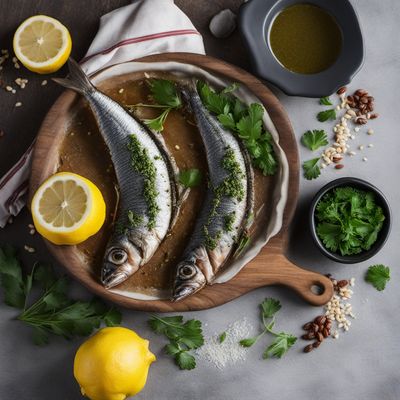
Ingredient
Pine nut kernels
The Nutty Delicacy: Unveiling the Secrets of Pine Nut Kernels
Pine nut kernels are small, ivory-colored seeds that have a soft, buttery texture and a mild, slightly sweet flavor. They have a distinctive elongated shape and are encased in a hard shell, which needs to be removed before consumption. These nuts are often used in both sweet and savory dishes, adding a delightful crunch and a subtle nutty taste. Due to their high oil content, pine nut kernels can turn rancid quickly, so it's important to store them properly to maintain their freshness.
Origins and history
Pine nut kernels have a long history dating back thousands of years. They are believed to have originated in the Mediterranean region and have been a staple in the diets of various cultures, including the ancient Greeks and Romans. Native American tribes in North America also utilized pine nuts as a valuable food source. Today, pine nut kernels are harvested from several pine tree species, including the stone pine, Korean pine, and Mexican pinyon.
Nutritional information
Pine nut kernels are a nutrient-dense ingredient, rich in healthy fats, protein, and essential minerals. They are an excellent source of monounsaturated fats, which can help promote heart health and reduce bad cholesterol levels. Additionally, pine nuts contain vitamin E, magnesium, and zinc, which contribute to overall well-being.
Allergens
Pine nut kernels are known to cause allergic reactions in some individuals. People with tree nut allergies should exercise caution when consuming pine nuts and consult with a healthcare professional if necessary.
How to select
When selecting pine nut kernels, look for ones that are pale ivory in color and have a uniform shape and size. Avoid nuts that appear discolored, shriveled, or have a rancid smell. Opt for reputable brands or suppliers to ensure the highest quality.
Storage recommendations
To maintain the freshness and quality of pine nut kernels, store them in an airtight container in a cool, dark place, such as the refrigerator or freezer. This helps to prevent the nuts from turning rancid and prolongs their shelf life.
How to produce
Pine nut kernels are typically harvested from pine cones. To produce them at home, one would need to obtain pine cones from suitable pine tree species, remove the cones, and extract the kernels by cracking the cones open. However, due to the labor-intensive process and the availability of commercially produced pine nut kernels, it is more practical to purchase them rather than producing them at home.
Preparation tips
Pine nut kernels can be enjoyed raw or toasted to enhance their flavor. They are commonly used in pesto sauces, salads, baked goods, and as a topping for pasta dishes. To toast pine nuts, simply heat them in a dry skillet over medium heat until they turn golden brown, stirring frequently to prevent burning. Be cautious as they can quickly go from toasted to burnt. Incorporate pine nut kernels into your favorite recipes to add a delightful nutty crunch and depth of flavor.
Substitutions
If pine nut kernels are not available, you can substitute them with other nuts such as slivered almonds, cashews, or walnuts, depending on the desired texture and flavor profile of the dish.
Culinary uses
Pine nut kernels are widely used in Mediterranean, Middle Eastern, and Italian cuisines. They are a key ingredient in traditional pesto sauce, where they provide a creamy texture and a rich, nutty taste. Pine nuts are also commonly used in salads, stuffings, desserts, and as a topping for roasted vegetables or grilled fish. Their versatility allows them to be incorporated into both sweet and savory dishes, adding a unique touch to various recipes.
Availability
Pine nut kernels are commonly available in regions where pine trees grow, including the Mediterranean, North America, and parts of Asia. They are also cultivated in countries such as Italy, Spain, China, and the United States.
More ingredients from this category

Yunnan Pine nut kernels
"The Nutty Delight: Unveiling the Richness of Yunnan Pine Nut Kernels"

Siberian pine nut kernels
"The Nutty Delicacy: Unveiling the Secrets of Siberian Pine Nut Kernels"

Swiss pine nut kernels
The Delicate Gems of the Swiss Alps

Other pine nut kernels
The Hidden Gems of the Forest

Korean pine nut kernels
"The Nutty Delight: Unveiling the Secrets of Korean Pine Nut Kernels"

Chilgoza pine nut kernels
The Nutty Delicacy: Chilgoza Pine Nut Kernels

Bhutan pine nut kernels
The Himalayan Nutty Treasure

Stone pine nut kernels
"The Delicate Delights of Stone Pine Nut Kernels"

Siberian dwarf pine nut kernels
The Tiny Nut with Big Flavor
Recipes using Pine nut kernels » Browse all

Sarde a Beccafico - Note by Note Style
The Symphony of Sarde a Beccafico: A Note by Note Delight

Korean Honey Cookies
Sweet Delights: Korean Honey Cookies

Spinach with Raisins and Pine Nuts
Savory Spanish Spinach Delight

Smoky Mussel Delight
Savor the Essence of the Sea with Smoky Éclade de Moules

Bahraini Bukaj Baklava
Golden Delights: Bahraini Bukaj Baklava

Acciughe sotto pesto with a Twist
Mediterranean Delight: Savory Anchovies in a Flavorful Pesto Marinade

Pizza Pesto Genovese
Savory Genovese Delight: Pizza Pesto with a Twist

Sicilian Stuffed Sardines
Mediterranean Delight: Sicilian Stuffed Sardines

Georgian-inspired Cheesy Potato and Pasta Bake
Kartopili Khachapuri - Georgian Cheesy Potato and Pasta Bake

Toronto-style Fattah with a Twist
Maple-infused Fattah: A Toronto Twist on a Levantine Classic

Kubbah qrāṣ with a Twist
Savory Delight: A Modern Twist on Lebanese Kubbah qrāṣ

Spinach Pesto Pasta
Verdant Delight: Spinach Pesto Pasta